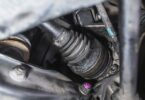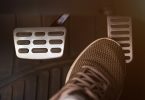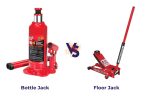Windshield wipers are essential to your safety inclement weather. While most of us don’t think much about using them, having a working knowledge of windshield wipers can help you use them efficiently. Here we look at signs your wipers need replacing, how to use them, tips for maintaining your windshield wipers, and how windshield wipers work.
Imagine trying to drive while moving a hand crank to work the windshield wipers on a rainy day. That’s precisely how drivers in 1917 did after the windshield wiper came into use. Today’s motorized windshield wipers are much more efficient and work at the twist of the lever.
How your wipers work
Windshield wipers, or wiper blades, attach to arms that move back and forth at different speeds to accommodate the weather. A motor controls the arms and speed of the wiper blades.
You can find the lever to operate most windshield wipers on the left side of the steering column. You can turn the wipers on by moving the lever down. You can adjust the wiper’s speed as you click the lever down further. Newer luxury model vehicles have rain-sensing wipers that engage with a few drops of rain.
If you need a quick swipe of the wiper, you pull it towards you. Pushing it toward the dashboard allows wiper fluid to clean the window with a swipe of the blades. Speed adjustment for the wipers is dependent on driving conditions. Whether you pull on a lever or turn the knob, windshield wipers provide a weather-free view of the road.
When to Replace Your Windshield Wipers
Like all other auto parts, eventually, you need to replace your wiper blades. These signs will help to identify when you should change the blades
Poor performance
Wipers that skip across the windshield aren’t working properly. Even if the blades still look good, it is essential that you change them out. Nothing is more dangerous than needing a clear view in a snow storm and poorly performing wipers.
Damaged rubber
We have all seen the tattered rubber wipers moving the water around but not clearing it from the windshield. Rubber damage happens when you pull a blade frozen to the windshield or just from wear and tear. Wiper blades don’t last forever; this is a telltale sign that you need new ones.
The wiper blade is bent
Your wipers in the wrong position at a car wash can bend the wiper. Pulling the arm up when stuck to a frozen windshield will do it too! Once the frame is bent, the blades don’t clean the window as they should, putting your windshield at risk of being scratched if you continue to use it. Get these changed before permanent window damage occurs.
The rubber dries out
Dry rubber becomes hard, the stiff wipers don’t clean as efficiently, and you can hear them scritching across the windshield as they move. Replace these before you get caught in a dangerous situation.
The wipers start talking
Noisy wiper blades that squeak, vibrate, click, or chatter aren’t cleaning the windows well. Chattering is usually because the arm is bent. For your sanity alone, they need replacing!
Streaky windshield
Anytime the wiper blades leave behind a streaky window, it’s time to replace them.
Replacing Windshield Wipers
Several things will affect the rubber on your wiper blades. The quality of the rubber on the blades definitely affects the longevity of the wipers. The more expensive the wipers, the better grade of rubber you get. The same is true for the cheapest blades you can buy.
Heat and increasingly lousy weather will wear out the blades. If you live in a highly snowy or rainy area where you use your windshield wipers daily, they will wear out sooner. This is true for areas with extremely cold or hot temps as well. This is why you need to buy higher-quality rubber wipers if you can afford them.
Inspecting your windshield wipers every few weeks will give you a good idea of when you need to replace the wipers. Your owner’s manual also recommends when to change the wiper blades, but a good rule of thumb is six to twelve months, or if you see one of the above signs, to replace them.
If you get a new car or are new to driving, it is a good idea to get familiar with the front and back windshield wipers before you drive in inclement weather. The following user guides should help.
Front windshield wiper use
- Find the wiper lever on the right side of the steering column. Some click up or down to adjust the speed and others have a dial that you turn to change the wiper speed. Even if your vehicle has the wiper lever on the left of the steering column, they all work the same!For “mist mode,” push the lever up, then back down to run the wipers once. This is great if you get road spray on your windshield in rainy weather.Depending on the vehicle, you may be able to hold the lever up to extend the wiper time, allowing you to control the time the wipers are activated manually. If you can’t do it manually, your car probably has an “intermittent mode” that automatically does the same thing.
- For “intermittent or continuous mode,” you push the lever down. Push down once for intermittent and twice for continuous. In intermittent mode, the wipers swipe every few seconds. In continuous mode, they swipe non-stop. Pushing the lever down the third time and the continuous mode moves faster.If you push the control lever in a vehicle with rain-sensing windshield wipers, you engage the “auto mode” so the car can match the wiper speed to the weather using sensors. If you choose the speed, use the continuous mode for heavier rain and the intermittent mode for lighter rain or snow.
- Most of today’s vehicles offer three wiper speeds. Use the lever control dial to choose your wiper speed. Familiarize yourself with the dial’s arrows and wording. Rotating the dial to you increases the wiper speed. Turning the dial away from you will slow them down.
- When you want to turn the wipers off, turn the dial to the “off” position. If you use the dial control on the lever, put it back in the starting position to turn off the wipers. If you’ve changed the wiper speeds, move the lever to the original position, and it will turn the wipers off.
Rear Windshield Wipers
On most vehicle levers, the rear windshield icon is on the control dial depicted by a rectangular windshield and wiper. Use this dial to control the rear wipers. Though some cars have a push button dial or the end of the lever can be pushed to engage the rear wipers.
To see if your vehicle has a rear windshield wiper, look at the back of the vehicle. Many cars do not have a back windshield wiper. You can use your owner’s manual for specific instructions for your vehicle.
Push or rotate the control that engages the rear windshield wiper. You can adjust the wiper’s speed in the “O” or on position. To turn the wipers off, push or turn the control into its original position or press the button.
Washing your windshield
- Pulling the lever to you coats the windshield in cleaning fluid. The longer you hold it, the more fluid will come out, then the wiper will clean the window. Once you release the lever, it will return to its original position.
- Move the control dial to align the washing line with the rear window icon to wash the back window. Once aligned, hold, then release the lever or button. You must push the lever away in some vehicles to engage the rear wipers. Many cars with rear windshield wipers don’t offer the option to wash the window.
Adding more windshield fluid
Eventually, the dashboard will light, telling you to refill the wiper fluid. You will need a gallon jug of windshield fluid and a funnel.
Step 1: Pop the hood and locate the windshield fluid reservoir found at the front top of the engine block.
Step 2: Open the cap, put in the funnel, and fill the reservoir to the max fill line on the front of the reservoir.
Step 3: Once filled, remove the funnel, close the cap, then close the hood.
Tips to extend the life of your windshield wipers
- Use the defroster: Ice ruins the wiper blades by bending the metal and tearing the rubber. Use the defroster to melt the frozen windshield BEFORE you use the wipers. Using an ice scrapper will make the process faster.
- Examine the rubber: Inspect your wipers every couple of weeks and more in inclement weather. Look for split, cracked, or missing rubber and damage to the metal of the wiper. Blades with missing or worn rubber can scratch the windshield!
- Clean off the dirt: Keep the windshield and the wipers clean. Use a moist cloth and rubbing alcohol to clean the wiper blades and window cleaner for the windshield. Cleaning the wipers monthly will keep them in excellent shape!
- Stay in the shade: The sun’s heat dries rubber—Park in the shade whenever possible, especially in scorching areas.










Leave a Comment